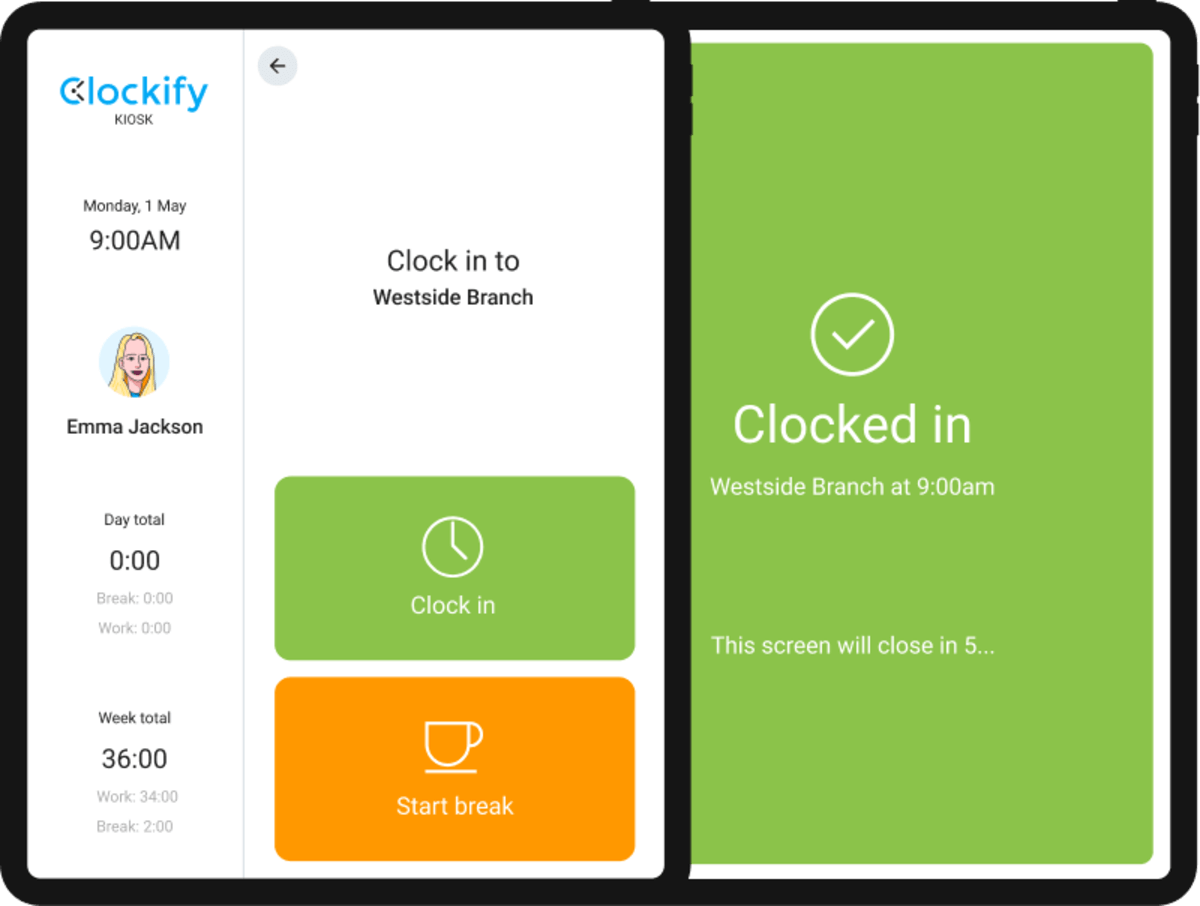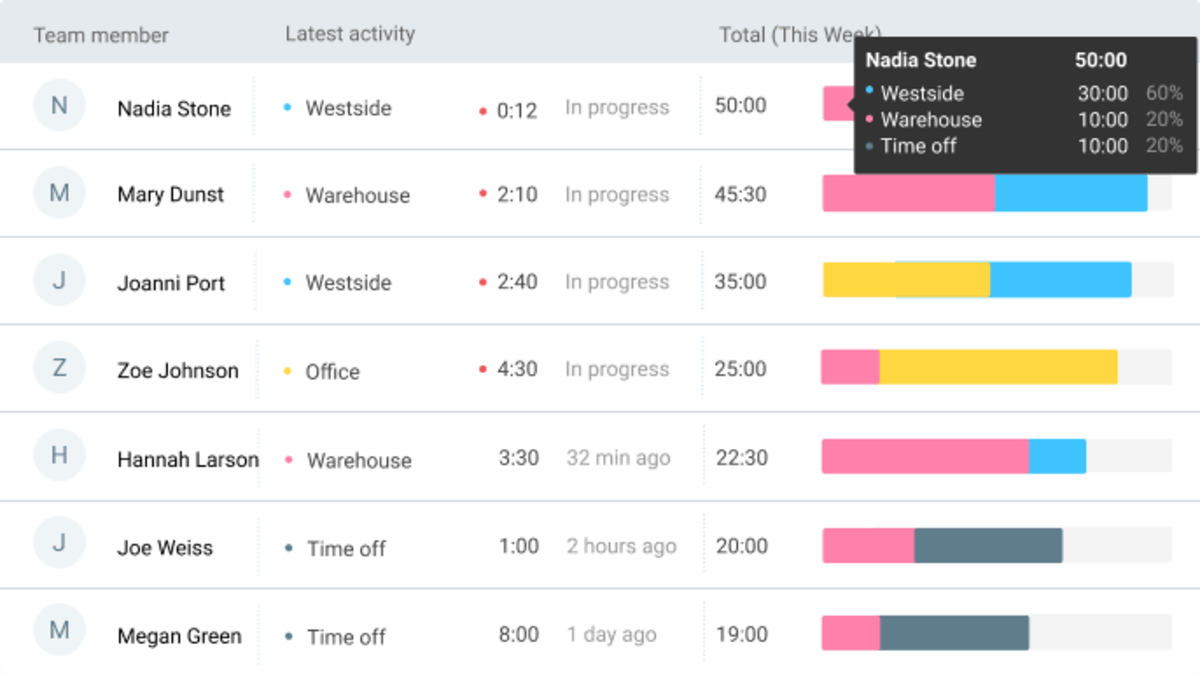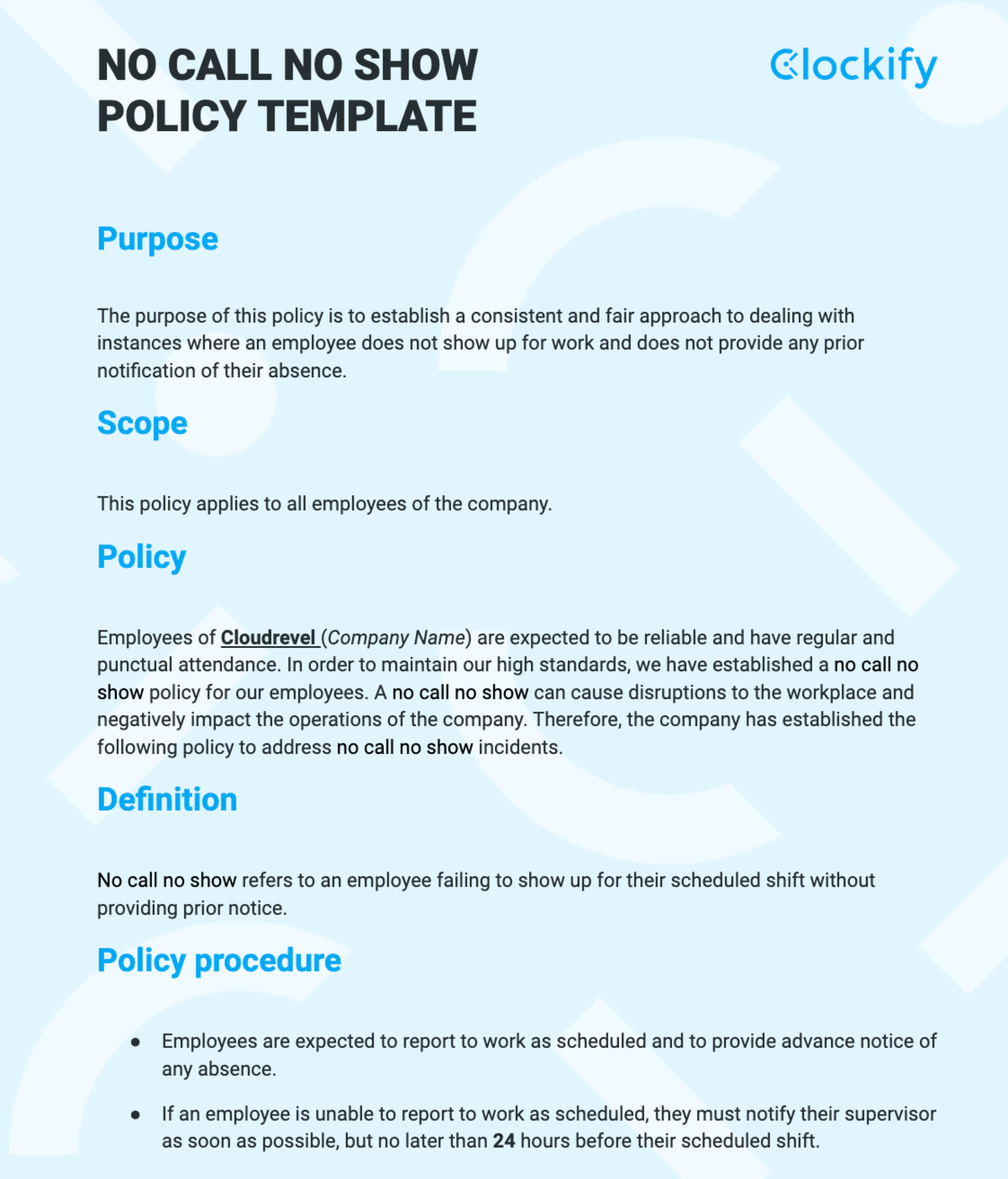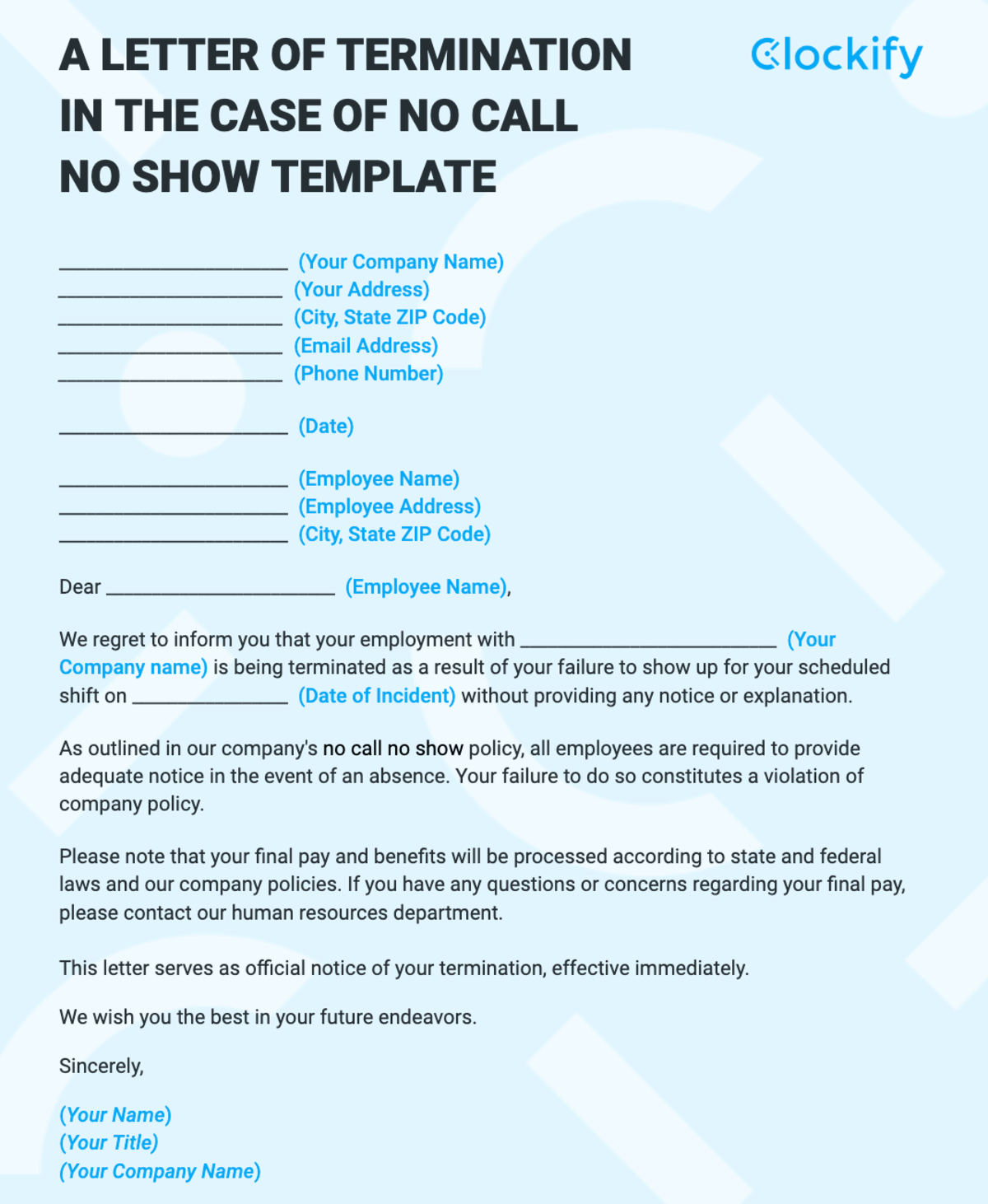How to handle no call no show cases + examples and templates
Last updated on: February 17, 2023
Have you ever had an employee who failed to notify you of their absence?
If you have, you know how no call no show situations can be challenging and stressful. When this happens, you must find a replacement, and other employees’ performance suffers as they must multitask between their own work and that of the absent employee. Furthermore, if you do not handle it well, your entire business may suffer.
So, how to handle no call no show cases — especially when they appear again and again?
We are here to help you answer that question and set up a system that will reduce the number of no call no show cases. In this blog post you can read about the following:
- What a no call no show case is,
- Valid reasons for a no call no show situation,
- Tips on how to deal with no call no show cases, and
- Why you should have a no call no show policy and how to create one.

Table of Contents
What is the legal definition of a no call no show?
According to Law Insider, a “No Show, No Call is defined as absenteeism from scheduled work without calling or showing up for work.” Simply put, a no call no show is a situation in which an employee doesn’t appear for a scheduled shift and fails to inform the company via phone, email, or other means of communication.
In the United States, no call no show policies are not regulated by federal law, but most employers have the right to terminate employees who do not show up for work without notifying the employer.
However, there may be some exceptions. According to the Washington State Department of Labor and Industries, employees in this state “earn at least one hour of paid sick leave for every 40 hours” they work. So, they are not required to notify their supervisor if they are absent from work due to serious illness (mental or physical), or if they need to care for a sick member of their family, among other things.
A similar situation occurs when an employee is protected by the Americans with Disabilities Act (ADA) or Family Medical Leave Act (FMLA) leave. Furthermore, if an employee is covered by a union contract, the terms of the contract may govern the no call no show policy.
So, employers have the right to establish their own no call no show policies, as long as they do not violate any other labor laws, such as anti-discrimination laws. When developing a no call no show policy, consult with an employment attorney or the Department of Labor in your state to ensure that your company is not violating any federal, state, or local employment laws.
What no call no show excuses are valid?
A valid no call no show excuse requires a situation in which an employee is unable to call and inform their manager of their absence.
According to attorney Terry Katz, the following are valid reasons to miss work:
- Car and other accidents (especially if an employee or their family members are injured),
- Emergencies (for example, situations in which employees’ or their family members’ life is endangered), and
- Death of a loved one.
It would be extremely difficult for an employee to call in before their scheduled shift during the aforementioned emergencies, so these situations should be considered valid reasons. Thus, managers should keep these reasons in mind when developing a no call no show policy.
In general, it is difficult to define what no call no show excuses are valid because each case is different. It is up to managers to establish ground rules and identify some valid general excuses that will be acceptable in the workplace. However, they should examine each case individually, while treating everyone fairly and equally.
How to deal with no call no show cases
We are all human, and we make mistakes. Sometimes also unexpected things and emergencies happen. Thus, a no call no show case will occur at least once, so managers should be prepared in advance.
But, how can you, as a manager, deal with no call no show cases?
We have created a list of tips on how to reduce no call no show situations and how to handle them when they occur.
Tip #1: Have a no call no show policy
A no call no show policy is one of the most important tools you can use to reduce and deal with no call no show cases. With a no call no show policy, employers and managers can put the rules of the workplace in writing and establish general rules of employee attendance and absenteeism.
A no call no show policy includes:
- Rules for no call no show cases,
- Disciplinary actions that the company undertakes in case of a no call no show, and
- Acceptable reasons for no call no show.
Why should you include disciplinary actions in your policy?
Well, rules and warnings delivered verbally lack weight, and employees frequently forget or overhear them. When employees have the consequences of no call no show situations laid out in an official company document, they will take these warnings much more seriously.
That is why it is critical to have a clearly defined no call no show situation and its consequences outlined in a formal no call no show policy.
Tip #2: Use a clock in/clock out app
Having a system for tracking work time and attendance is extremely useful in no call no show situations as you can easily detect when someone is missing. This is especially important when you run a large company with a lot of employees. Managing so many employees is a challenging task, and tracking attendance can be simplified by using attendance and time tracking software.
With a free time tracking app such as Clockify and its specialized time clock kiosk, you will always know whether your employees arrived to work or not. You can easily set up a shared kiosk at your company’s entrance and let your employees clock in and clock out from a single device.

When all employees clock in this way, it is easy to see who is absent from work. Thus, you can take the necessary steps and deal with no call no show situations in a timely manner.

💡 Clockify Pro Tip
If you want to learn more about how to manage a team, read our blog post:
Tip #3: Use a team chat app
A modern workplace requires an efficient and quick mode of communication to avoid or reduce no call no show situations. There are numerous chat and collaboration tools available, such as Pumble, that offer a variety of features aimed at enabling real-time communication between two or more employees.
This way, your employees can contact you at any time and notify you if they have an emergency and are unable to show up for work. They can also attach a document as written proof of why they are unable to come to work.
Improved communication can lead to better collaboration and teamwork which are a key to better productivity and enhanced work organization.
When you have a reliable communication system and good relationships among coworkers, no call no show cases are close to non-existent.
💡 Clockify Pro Tip
To find out more about the best chat apps, read our blog post:
Tip #4: Encourage open communication with your employees
Open and honest communication with your employees is essential for a successful business. You should try to encourage transparent communication with your employees and foster a culture in which people feel comfortable asking for time off or assistance when they are dealing with personal issues. This will lead to improved collaboration and team organization.
Finally, if your employees feel free to ask for time off whenever they need it or do not hesitate telling you about any problems they have, no call no show cases may become a thing of the past. Good and honest communication is built on trust, and when there is trust, your employees feel comfortable telling you about their problems and why they can’t come to work.
Tip #5: Define how many no call no shows before termination
The number of no call no shows before termination is not fixed and can vary depending on the company’s policy and the circumstances of each situation. Some employers may have a strict policy, such as three no call no shows in a year leading to termination, while others may take a more flexible approach.
Finally, employers determine how many no call no shows are permitted before termination. After consulting with the HR team, they should clearly state that number in the company’s no call no show policy.
Tip #6: Determine what to do if an employee fails to show up for work
There are certain steps you, as a manager, should take when an employee doesn’t show up for work and fails to notify you of their absence.
These steps are:
- Step #1: Inform the human resources and attempt to call the employee.
- Step #2: Make a call to the employee’s emergency contact list if the employee doesn’t answer.
- Step #4: If you manage to get in touch with either the employee or their emergency contact, and find out the reason of the no call no show you can decide what will be the next step — if the employee has an emergency situation, see if you can help, or if the employee does not have an acceptable reason, find a replacement first and then enforce disciplinary actions.
- Step #5: Document the absence in the employee’s file.
- Step #6: Evaluate the situation — you should consider the circumstances surrounding the absence, such as the employee’s past attendance record and the reason for the absence.
- Step #7: Address the absence with the employee — if the employee has a history of poor attendance, you should have a meeting with the employee to discuss the issue and the consequences of continued absences.
- Step #8: Implement disciplinary action — if the absence is a violation of company policy, you should implement disciplinary action.
Each situation is unique, and employers should consider all relevant circumstances as well as follow the laws and regulations that apply to their workplace including American with Disabilities Act (ADA) leave or Family Medical Leave Act (FMLA). Because if you fire an employee for breaching the no call no show policy, they may have a stronger case for FMLA or ADA discrimination if they had a leave within the previous year.
Tip #7: Reward good behavior
One of the good ways of encouraging punctuality and reducing no call no show situations is giving rewards in the form of incentives for good attendance.
Psychology has taught us that rewards are great motivators and even more effective than punishments. Good rewarding systems have the potential to raise employee motivation and performance by up to 44%.
You should consider giving the following incentives to your employees:
- Tangible goods, such as presents, gift baskets, and traveling opportunities,
- Intangible rewards, such as employee recognition or praise, and
- Monetary incentives such as bonuses or gift cards.
Tip #8: Implement disciplinary action for no call no show policy violation
Just as you should reward good behavior, you should also take disciplinary actions against an employee who violates the no call no show policy.
Managers usually decide what those actions are, but be careful. While you want to build discipline and gain the respect of your staff, you also want to prevent any Devil wears Prada or Horrible Bosses-style situations where, instead of gaining their respect, they begin to resent you.
There is no one-size-fits-all no call no show policy, and it is up to each company to define its own internal rules regarding the no call no show policy, as no call no show cases are not regulated by law. While doing so, keep in mind state and federal laws in the state where your business is located, such as labor law, so that you don’t break them by enforcing your no call no show policy.
For example, when a no call no show incident occurs, you may issue:
- A verbal warning for the first occurrence,
- A written warning for the second incident, and
- Suspension or termination of employment for the third occurrence.
These disciplinary actions should be clearly stated in a no call no show policy, so that employees know the consequences of their behavior.
On the other hand, when deciding what type of disciplinary action to include, you should carefully consider FMLA and ADA to reduce the possibility of being accused of unfair dismissal.
Furthermore, although it is not required by law, you should document all previous verbal and written warnings so that you have evidence that you warned and informed your employees about their misconduct, and that you gave them a chance to change their behavior — in case the dismissed employee sues you for wrongful termination.
Why should you have a policy for no call no show cases?
Having a no call no show policy can provide many advantages to your company and protect it from these unforeseen no call no show cases. You should be prepared in advance and have clearly laid out no call no show policy rules.
Here are some of the most common benefits of having a no call no show policy.
Benefit #1: Improving employee productivity
One of the most important benefits of having and enforcing a no call no show policy for your business is certainly improved employee productivity.
According to the Society of Human Resource Management, unscheduled absences from work result in a 36.6% decrease in productivity.
So, what’s the link between no call no show and lower productivity?
Well, when a no call no show occurs, you are left without an employee whose job must be completed regardless. As a result, you will either find a replacement or divide their workload among other employees. This situation puts pressure on the entire team, resulting in stress, anxiety, and burnout. Naturally, working in such an environment will only hinder employee productivity.
Although you can’t expect to prevent no call no show from happening ever again, you can significantly reduce it by introducing a no call no show policy.
Consequently, the productivity and efficiency of your employees will increase. Your employees will be able to focus on their tasks rather than attempting to multitask by doing their own and their colleagues’ work at the same time.
Finally, having a no call no show policy and correctly enforcing it will benefit your business and help it run smoothly and efficiently.
Benefit #2: Preventing system abuse
Without a no call no show policy, some employees may take advantage of the system by failing to show up for work without notice, knowing that there will be no consequences. A no call no show policy helps to prevent this by holding employees responsible for informing their employer when they are unable to work.
According to Jeffers, Danielson, Sonn & Aylward, P.S.:
“The law and regulations allow employers to require employees to notify them as soon as practicable of their need to use paid sick leave and generally prior to the start of a missed shift.”
That said, an employee can be required to provide advanced notice of their absence. So, by clearly presenting your employees with the rules and consequences of no call no show in your policy, you are preventing system abuse. When you have a no call no show policy in place, your employees will understand what is and is not permitted. As a result, they are less likely to take advantage of the system.
Benefit #3: Saving money
Without a no call no show policy, you are likely to spend money finding a replacement for the absent employee or compensating other employees for overtime. So implementing a no call no show policy can actually save you money.
Here are the ways in which no call no shows can have a financial impact on your company:
- Overtime costs — when an employee doesn’t show up for work, other employees may have to work overtime to cover their shifts, which can increase labor costs. According to the Society of Human Resource Management, the total cost of overtime due to absences as a percentage of payroll was 5.7% in 2013.
- Replacement costs — the costs of employing temporary workers or other extra workers (other than existing employees) to cover for employee absences.
- Increased cost of absenteeism — if there are no rules regarding no call no shows, employees will see an opportunity to miss work more frequently. As a result, your finances and business will suffer. According to the Society of Human Resource Management, the total cost of productivity lost as a percentage of payroll of unplanned absence was 6.7% in 2013.
A no call no show policy can help you reduce these costs by introducing clear rules regarding no call no show cases and increasing employee awareness of the consequences of breaking these rules.
When employees understand that there will be consequences if they do not show up for work without notice, they are more likely to be reliable and show up for their scheduled shifts.
Consequently, you won’t have to spend money and time on finding and training a replacement, and other workers will be more productive because they won’t have to take over someone else’s job.
How to create a no call no show policy
Creating a no call no show policy involves:
- Defining the expectations for employee attendance — being punctual and informing their supervisors when they are unable to work, and
- Outlining the consequences for failing to meet those expectations.
Here are some steps you can take to create a no call no show policy for your company.
Step #1: Define the policy’s purpose
Clearly state the purpose of the policy, which is typically to ensure that employees are aware of the expectations and consequences of failing to show up for work without proper notification. Expectations vary by company, but they are typically related to employee punctuality and regular attendance, as well as timely notification of absences.
Step #2: Specify what qualifies a no call no show occurrence
Give a clear definition of what constitutes a no call no show (i.e., an employee who does not show up for their scheduled shift without prior notice).
Step #3: Outline the policy
Clearly state that any employee who fails to show up for work without proper notification will be considered a no call no show.
Step #4: Define proper notification
Employers should specify in the policy what constitutes proper notification, such as providing advance notice to a supervisor or manager, either in person or via:
- Phone,
- Email, or
- Text message.
As Laurence Donoghue, an attorney with Morgan, Brown & Joy explained in the SHRM article:
“Given the variety of communication tools we have now, I think it is more difficult for an employee to justify a failure to call in.”
In conclusion, as an employer, you should specify what constitutes proper notification of absence and the time frame within which employees must notify supervisors.
Step #5: Lay out the disciplinary procedure
Give details on the consequences for no call no show offenses, such as:
- A verbal warning for the first occurance,
- A written warning for the second occurrence,
- A pay suspension for the third occurrence, and
- Termination of employment for the fourth occurrence.
Step #6: Include a list of acceptable no call no show events
Allow for exceptions in the event of an emergency or unanticipated circumstances, and make it clear that workers must notify their supervisor or managers as soon as possible to give an explanation for their absence.
These exceptions can include:
- Extreme weather conditions,
- Personal or a close family member’s illness,
- Serious accidents, and more.
Step #7: Clearly communicate the no call no show policy to your employees
Explain the policy rules to all employees in a clear and straightforward manner, whether it’s through:
- An employee handbook,
- An in-person meeting, or
- An email.
In addition, you should allow your employees to ask any questions they may have about the no call no show policy.
💡 Clockify Pro Tip
If you want to learn about how to track attendance of your employees, read our blog post:
Step #8: Review and update the policy
Review and update the policy as necessary, taking into account changes in the company, laws and regulations in your state, and employee feedback.
Let employees give their feedback on the no call no show policy. This way, you will prevent any misunderstandings and ensure employees know their rights and obligations.
Furthermore, you should stay up to date on all changes in federal and state laws, such as labor law, to ensure that you are in compliance when enforcing your no call no show policy.
Step #9: Consider any local, state or federal law which may affect your no call no show policy
As mentioned in the previous step, you should always be informed about state labor laws.
The policy should be in accordance with the laws and regulations of the state and country. It’s important to consult with legal counsel before finalizing and implementing any policy to ensure that it is compliant with all applicable laws and regulations such as Fair Labor Standards Act (FLSA) that governs the following:
- Setting overtime pay,
- Working time regulations, and
- Employee time tracking.
No call no show policy example
As we have already stated, having a no call no show policy is one of the most important ways you can deal with no call no show situations.
Sometimes you will be too busy to create your own policy or you won’t know where to start. To make it easier for you, we made a no call no show policy template that you can use on such occasions.
As you can see from the screenshot below, this no call no show policy covers all the steps that we have previously mentioned, such as:
- The purpose of the policy,
- Policy procedure,
- Disciplinary action, and
- Valid excuses.

Download a free no call no show policy template
When you want to use this no call no show template for your company, you need to include the name of your company as well as the type of disciplinary action you want to enforce when a no call no show occurs.
How do I write a termination letter for no call no show?
When an employee has a string of no-shows, the last disciplinary action is a termination.
In such cases, you should send a termination letter to the employee, which is a formal document written in a professional and respectful tone.
The termination letter should include the following details:
- The employee’s name and job title,
- The date(s) of the missed work,
- A statement that the employee failed to call or show up for work without notice,
- A reminder of the company’s no call no show policy and how the employee’s actions violated it,
- The date of the termination, and
- Your signature and contact information.
It is important to have a clear and consistent no call no show policy in place.
To make the process of terminating an employee easier for you, we created a free termination letter template that you can download.

Download the Letter of termination template
As you can see from the screenshot above, this letter of termination template includes all of the necessary elements that we have mentioned, and you only need to include information about your company and the employee to whom you are sending it.
Now, in general, are you required to document all warnings before termination?
Well, the FLSA only requires documenting and keeping a record of employee hours worked. In addition, you are not legally required to document previous warnings or to give written warnings to your employees, but it is a good practice. Written warnings and documentation of all previous warnings and disciplinary actions are important for you as an employer, because they reduce the likelihood of you being accused of wrongful termination. They show that you have given a chance to your employee to change their behavior.
Wrapping up: Introduce a no call no show policy
Although no call no show cases are not uncommon at a workplace, you should be able to reduce them and bring the situation under control by following the tips we have listed in this blog post, such as:
- Having a no call no show policy,
- Using a clock-in/clock-out app,
- Having a reliable team chat app,
- Encouraging open communication between managers and employees, and
- Rewarding good behavior and taking disciplinary action for bad conduct.
With these tips, you’ll be prepared for any unexpected no call no show situations, while the number of no call no show situations will be reduced. Employee attendance and productivity will also improve as they will be focused solely on their own tasks.
Furthermore, with our free no call no show policy template, you have everything you need to create your own company’s policy. Finally, this policy will help you reduce no call no shows and avoid ridiculous “a dog ate my homework” excuses.
✉️ Have you ever dealt with a no call no show situation? Do you have any useful tips on how to handle these situations that we haven’t mentioned yet? Feel free to share your opinion. Write to us at blogfeedback@clockify.me and we will consider featuring your answers in this or one of our future pieces. And, if you liked this article, share it with someone else you know will find it useful.





